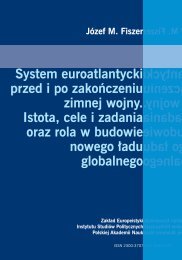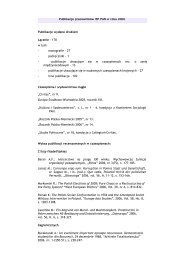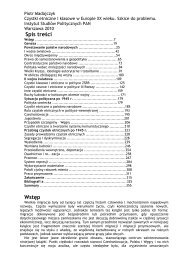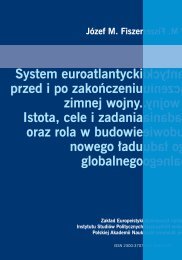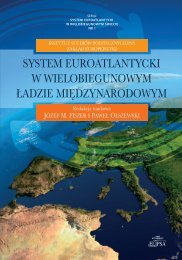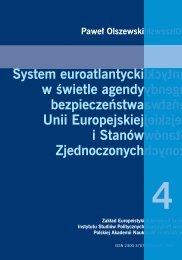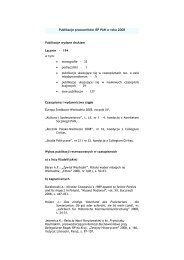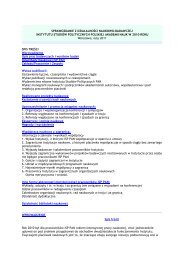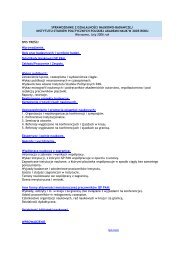Kultura i SpoÅeczeÅstwo t. 55 nr 4/2011
Kultura i SpoÅeczeÅstwo t. 55 nr 4/2011
Kultura i SpoÅeczeÅstwo t. 55 nr 4/2011
- No tags were found...
Create successful ePaper yourself
Turn your PDF publications into a flip-book with our unique Google optimized e-Paper software.
century – the majority of newly-established museums are located in adapted old buildings, themuseums representing almost exclusively only two categories: historical museums andcontemporary art museums. The Author seeks an answer to a question whether museums mustfollow current trends. She concludes that a quest for success translating to a good image andhigh attendance is and certainly shall remain an important goal of a museum. She warns,however, of dangers related with a museum trying to be a ‘trendy’ place to attend, especiallyin the times of public life commercialization, which is more and more common.Key words / słowa kluczowehistorical museums / muzea historyczne; museums of contemporary art / muzea sztukiwspółczesnej; postindustrial architecture / architektura postindustrialnaTomasz StryjekIn his article the Author examines the notion of remembrance policy, the importance ofremembering the events of the period 1939-1953 for contemporary identity politics in thecountries of Central and Eastern Europe: Poland, Ukraine, Lithuania, Latvia and Estonia aswell as the course of a conflict about the memory, which escalated between those countriesand Russia particularly between 2005-2010. The Author introduces a term "remembrancepolicy model ", which concerns the balance of powers among political actors in a givenstate, who influence the shape of this aspect of the state policy. He also analyses the statestrategies of the remembrance policy in international relations within the region, with specialattention to Lithuania and Ukraine. He examines reasons for the success of the policy ofremembering the 1939-1953 events in Lithuania in 1991-<strong>2011</strong> and a failure of such policy inUkraine in 2005-2010. The sources of difference between the effects of these two policieslie, in his opinion, not only in far greater ethnic and identity homogeneity of the Lithuaniansociety, but also in the fact that the EU gave an early, clear and consistent support foreconomic, social and political transformation of that country, which was, unfortunately, notprovided to Ukraine - either after its establishment in 1991, or after the Orange Revolutionin 2004.S u m m a ryAutor analizuje pojęcie polityki wobec pamięci, znaczenie pamięci o wydarzeniach okresu1939-1953 dla współczesnej polityki tożsamości w państwach Europy Środkowej iWschodniej: Polski, Ukrainy, Litwy, Łotwy i Estonii oraz przebieg konfliktu o pamięć, jakize szczególną siłą toczył się między nimi a Rosją w latach 2005-2010. Autor wprowadzatermin „model polityki wobec pamięci”, który dotyczy układu sił między podmiotamipolitycznymi w danym państwie wpływającymi na kształtowanie tej polityki. Zajmuje siętakże strategiami państwowej polityki wobec pamięci w stosunkach międzynarodowych wtym regionie, szczególną uwagę poświęcając Litwie i Ukrainie. Rozpatruje przyczynysukcesu polityki wobec pamięci o wydarzeniach okresu 1939-1953 na Litwie w latach 1991-<strong>2011</strong> oraz fiaska takiej polityki na Ukrainie w latach 2005-2010. Źródła tej różnicy tkwią,jego zdaniem, nie tylko w zdecydowanie większej homogeniczności etnicznej itożsamościowej Litwy, lecz także w tym, że UE udzieliła wczesnego, jednoznacznego ikonsekwentnego poparcia dla transformacji gospodarczo-społecznej i politycznej tegopaństwa, nie nastąpiło to natomiast w odniesieniu do Ukrainy – ani po jej powstaniu w 1991r., ani po pomarańczowej rewolucji w 2004 r.8



